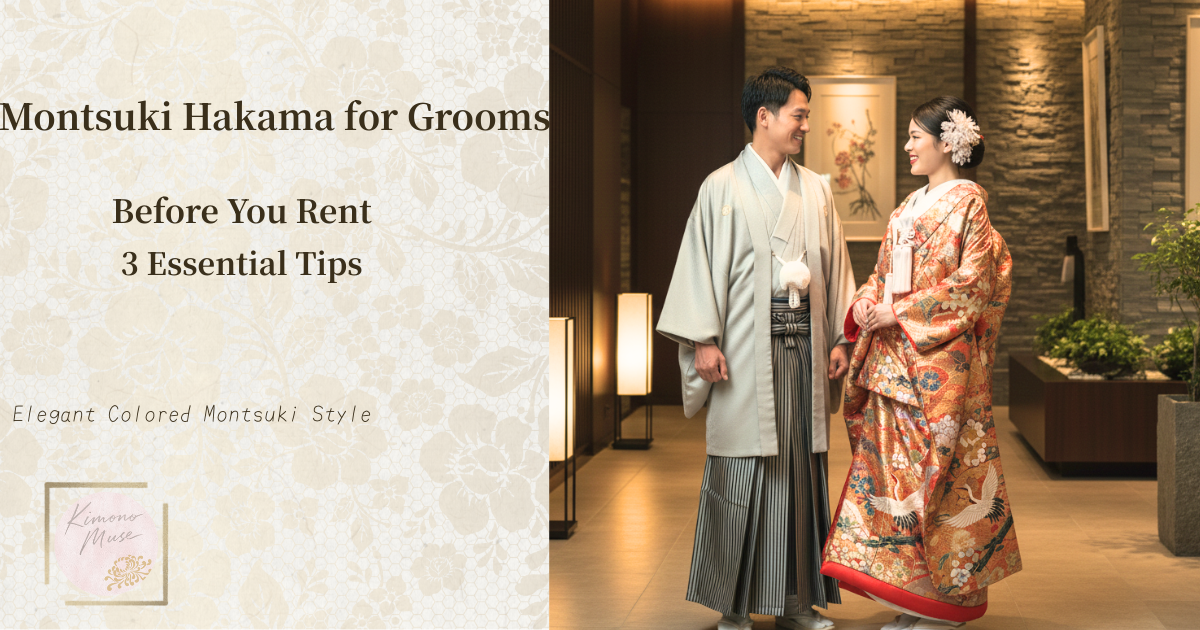A wedding is one of the most meaningful milestones in life.
Among them, a ceremony held in traditional Japanese attire offers a time of elegance—graceful, serene, and filled with cultural beauty.
However, purchasing a full set of montsuki hakama can be quite expensive.
That’s why many grooms today choose kimono rental services, which balance quality and cost without compromising tradition.
In this article, we share three key points for choosing the right montsuki hakama, along with helpful tips to help first-time grooms find the one that truly reflects their personality and spirit.
What Is the Groom’s Montsuki Hakama?

The montsuki hakama is the most formal traditional attire for grooms in Japanese weddings.
It consists of three main pieces—the haori (jacket), kimono (inner robe), and hakama (trousers)—and features family crests on the back, chest, and sleeves, symbolizing sincerity and respect.
Its origins trace back to the formal attire of samurai, who wore garments bearing their family crest as a sign of honor and courtesy.
This spirit of “expressing respect through attire” continues today, carried on in the groom’s traditional wedding ensemble.
While black remains the classic choice, modern grooms increasingly embrace a wider range of colors to reflect their own personality and sense of style.
Below are three representative styles commonly seen today.
| Style | Features | Occasions |
|---|---|---|
| ① Black Montsuki Hakama | Highest Formality – The haori (jacket) and kimono are made of deep black silk, the most formal color combination. This style is traditionally worn to match the bride’s white kimono (shiromuku) or richly embroidered iro-uchikake, ensuring both outfits share equal dignity. | Shinto wedding ceremonies, formal receptions, and commemorative photos |
| ② Colored Montsuki Hakama (Plain Colors) | Elegant with Subtle Color – Shades such as white, gray, navy, or green express individuality while maintaining a refined tone. Considered semi-formal compared to the black montsuki. | Wedding receptions, after-parties, or semi-formal photo sessions |
| ③ Patterned or Designed Montsuki Hakama | Expressing Personal Style – Fabrics may include woven patterns or subtle luster, allowing more creative coordination. Ideal for those who want a modern or stylish look while respecting tradition. | Wedding receptions, casual photo sessions, or pre-wedding portraits |
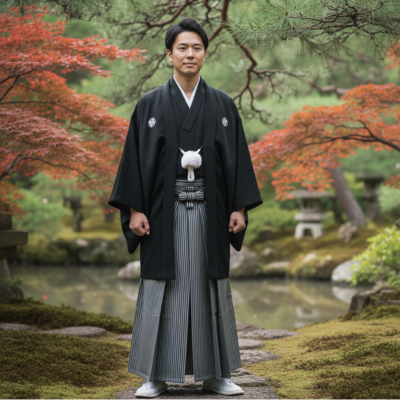
The classic black montsuki hakama – the highest formality in groom’s attire, symbolizing dignity and respect in a traditional Japanese wedding.

A refined light-purple montsuki hakama expressing individuality while maintaining elegance; perfect for modern ceremonies or indoor venues.
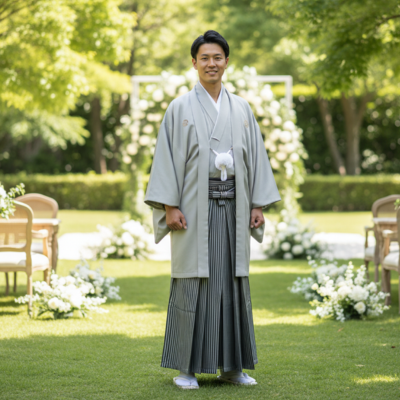
A graceful gray montsuki hakama blending formality with a calm modern touch, ideal for garden weddings and relaxed receptions.
3 Key Points to Choose the Right Montsuki Hakama (Before Renting)
When renting a montsuki hakama, many grooms wonder,
“How do I know which one is right for me?”
Choosing solely by color or design can sometimes lead to a look that feels unbalanced or awkward on the wedding day—especially in posture and silhouette.
After seeing many grooms during kimono dressing, I can say with certainty that small differences in tailoring, sizing, and hakama length have a remarkable impact on the overall impression.
Even with the same black montsuki, the ideal shade and fit can vary depending on body shape and posture.
Based on these experiences, here are three key points to avoid mistakes when choosing your attire.
By paying attention to formality, sizing, and the harmony of color and fabric, you can confidently select a montsuki hakama that suits you beautifully in any setting.
①Understand Formality — Crest Count and Color Determine the Dress Rank
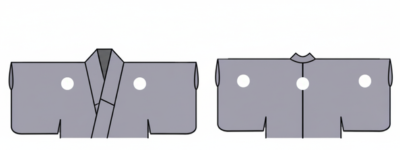
When choosing traditional wedding attire, the first step is to consider
“where the ceremony will take place, and who you will be standing beside.”
In Japanese formalwear, the appropriate level of dress is determined by the setting and by the attire of those with you.
When both the bride and groom wear traditional kimono, it is customary to match the level of formality so their outfits are in harmony.
If the bride chooses classic bridal kimono such as shiromuku, iro-uchikake, or hikifurisode,
the groom traditionally pairs it with a black montsuki haori-hakama with five family crests, the highest formal style.
The combination of a white bridal kimono and black montsuki hakama has long been regarded as the most formal and timeless ensemble for a Japanese wedding.
On the other hand, if the bride opts for a more modern or slightly casual look—such as “new-wafuku” styles that blend Western elements—
a colored montsuki in elegant, subdued tones creates a beautifully balanced coordination.
| Bride’s Kimono | Level of Formality | Recommended Groom’s Attire | Notes |
|---|---|---|---|
| Shiromuku (White Bridal Kimono) | The most formal bridal attire in Japanese tradition. | Black montsuki haori-hakama with five family crests | The most formal combination. Ideal for Shinto ceremonies and highly formal receptions. |
| Iro-Uchikake (Colorful Over-Kimono) | Equally formal as the shiromuku, characterized by elegance and rich decoration. | Black montsuki haori-hakama or colored montsuki haori-hakama | Matching formality is key. A traditional style that also photographs beautifully. |
| Hikifurisode (Trailing Long-Sleeved Kimono) | Graceful and refined, offering an elegant impression. | Black montsuki haori-hakama or colored montsuki haori-hakama | For formal occasions, black montsuki is ideal; for receptions, a colored montsuki is also appropriate. |
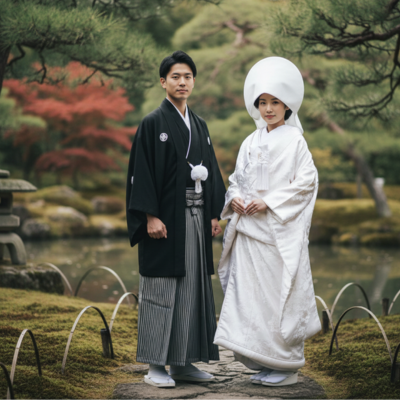
Traditional elegance at its highest — the bride in pristine shiromuku and the groom in a formal black montsuki haori-hakama with five crests. A timeless pairing for classic Japanese weddings.

A graceful iro-uchikake paired with a soft-tone colored montsuki hakama, creating a refined and harmonious look for a traditional garden setting.
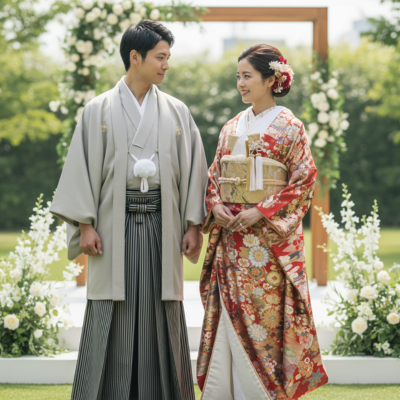
A beautifully coordinated couple in iro-uchikake and a light-colored montsuki hakama, perfect for modern outdoor ceremonies inspired by Japanese tradition.
▶ Learn more about bridal kimono selection, dressing, and budgeting in this in-depth guide:
Creating the Perfect Japanese Bridal Kimono LookA Complete Guide to Attire, Dressing, and Costs
②Get the Right Fit — Tailoring for a Beautiful Silhouette
When renting traditional attire, fit is one of the most important factors to consider.
Even slight differences in length can change both your silhouette and comfort.
As a general guideline, the haori (jacket) should fall just over the hip bones,
and the hakama should be long enough to show the ankles slightly.
If the lengths are too long, the hem may ripple and look untidy;
too short, and the posture can appear unsettled or unbalanced.
When checking the fit, pay attention to height, yukitake (sleeve-to-sleeve arm length), hakama length, and sandal size.
Most rental services offer fittings and consultations in advance.
During the fitting, try lifting your arms and sitting down while wearing the haori to ensure ease of movement and comfort.
③Choose Color and Fabric — Finishing Touches That Reflect Your Style
While black montsuki remains the most formal and traditional choice,
many grooms today opt for calm tones such as navy, gray, or white.
Choosing a color that feels true to you—while still harmonizing with the ceremony’s atmosphere and the bride’s attire—creates a refined and personal look.
Accessories such as zōri sandals, obi belt, and folding fan also play an important role, subtly shaping the overall impression.
By keeping the color palette consistent, you can achieve a sophisticated and well-balanced ensemble.
Pure silk (shōken) is ideal for authenticity and elegance,
but lightweight synthetic fabrics can be more practical and comfortable.
When renting, consider the balance of color, fabric, and accessories to find a style that best represents you.
Rental Process for Montsuki Hakama
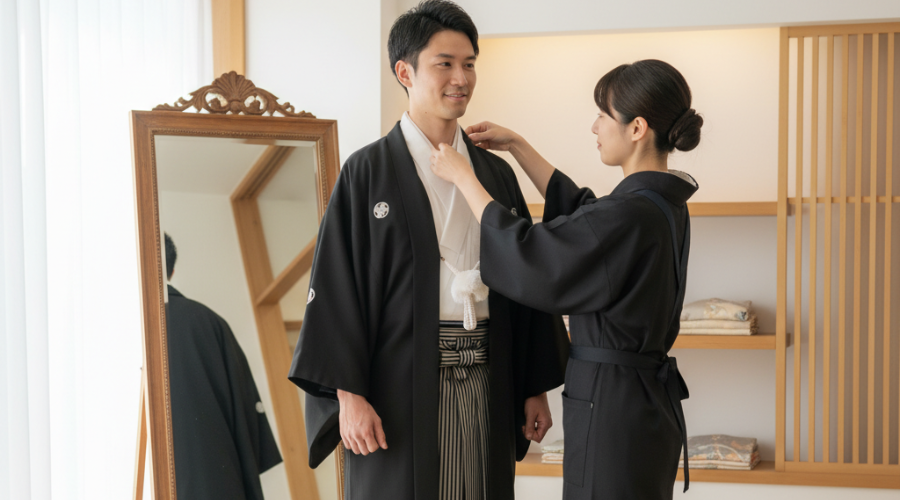
Wearing traditional Japanese attire for your wedding adds a memorable touch to this once-in-a-lifetime occasion.
However, for those who are not familiar with kimono, the rental process can seem a bit confusing at first.
Here, we’ll walk you through the basic steps — from reservation to the wedding day and return — so you can enjoy a smooth and stress-free experience.
1. Reservation & Consultation
Once your wedding date is set, contact a rental shop as early as possible.
Popular seasons can book up quickly, so securing your outfit 3–4 months in advance is recommended.
During your visit, you will try on the attire, take measurements, confirm colors and patterns, and finalize your rental contract.
2. Preparation Before the Day
Check whether your rental package includes essentials such as tabi socks, zōri sandals, and accessories.
If not, arrange additional rentals or purchases.
It’s also a good idea to prepare a haori or rain protection in case of bad weather.
Kimono dressing takes time, so plan to start getting ready about two hours before the ceremony.
3. Dressing & Return on the Wedding Day
On the wedding day, dressing is typically done by professional kimono stylists.
Some shops also offer on-site dressing services, depending on your venue.
After the ceremony, handle the garments with care and return them by the specified date.
Most rental services do not require cleaning — simply return the items as they are.
What You Need for a Montsuki Haori-Hakama
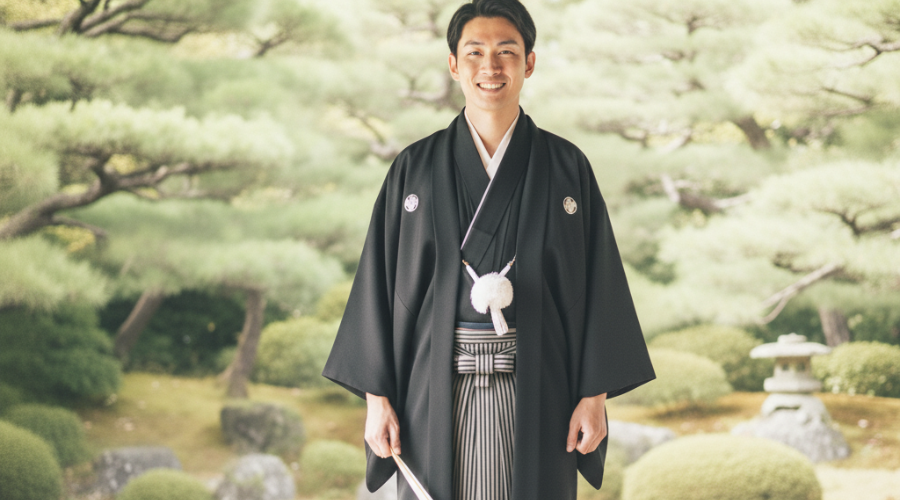
The montsuki haori-hakama outfit is created by combining several traditional garments and accessories.
In many rental packages, most items are included, but you may need to prepare certain basics yourself, such as undergarments or tabi socks.
Here is a simple overview of the essential components and their roles.
| Category | Items | Role / Key Points |
|---|---|---|
| Main Garments | Haori (jacket), kimono, hakama | The core three-piece set of traditional formalwear. The haori features family crests. |
| Accessories | Nagajuban (under-kimono), obi (belt), haori strings, fan | Essential items that complete the formal look and maintain proper style and structure. |
| Footwear | Tabi socks, zōri sandals | Proper fit is important. Practice walking in them to feel comfortable. |
| Other Items | Undergarments, hip pads, towels for dressing support | Additional innerwear and padding used by dressers to achieve a smooth and secure fit. |
Components and Their Roles
The montsuki haori-hakama is composed of multiple layers of traditional garments and accessories.
Let’s take a closer look at each element and understand what makes the outfit come together beautifully.
Nagagi (Inner Kimono)
The kimono worn beneath the haori.
For the formal black montsuki with five family crests, the nagagi is traditionally made of glossy habutae silk with the crests dyed directly into the fabric.
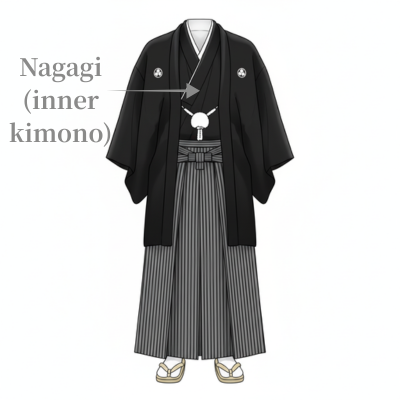
Nagajuban (Under-Kimono) and Haneri (Collar)
An undergarment worn beneath the nagagi.
It is often made of white habutae or shioze-habutae silk, giving a clean and refined impression around the neckline.

Hakama
A pleated garment worn from the waist down.
For the formal black montsuki ensemble, Sendaihira striped hakama are considered the most prestigious and traditional choice.
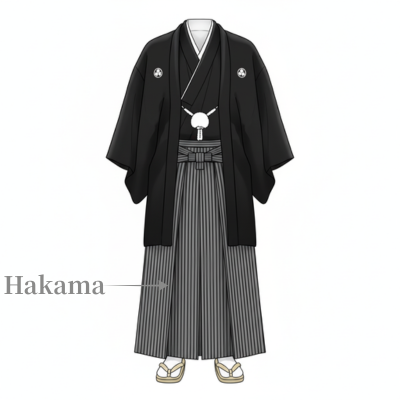
Obi (Kaku-obi Belt)
A men’s sash used to secure the hakama.
A kaku-obi made of pure silk provides a firm hold and helps maintain a neat, elegant appearance.
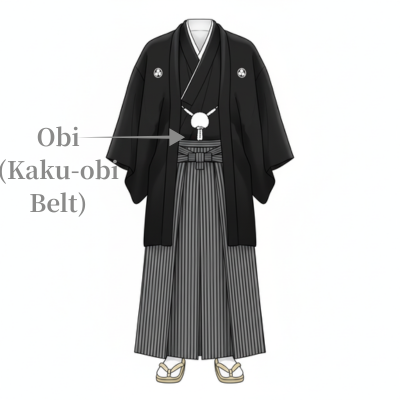
Haori (Formal Jacket) & Haori-himo (Cord)
A formal jacket worn over the kimono.
For the most traditional style, a black habutae haori with crests dyed into the fabric is used.
Choosing a white haori-himo (cord) completes the look with a refined, dignified touch.
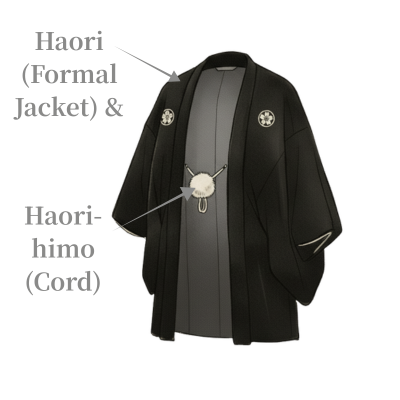
Zōri (Formal Sandals) & Sensu (Folding Fan)
Zōri with a tatami-style sole and white straps are the formal standard.
Carrying a white folding fan adds an extra touch of traditional elegance to the ensemble.

Frequently Asked Questions (Q&A)

**Q1. When should I reserve a montsuki hakama rental?**
Popular seasons (spring and autumn) book up quickly,
so it’s best to make your reservation 3–4 months before the wedding.
Booking early also gives you time to carefully choose the right size and design.
**Q2. Do I have to choose a five-crest montsuki?**
It depends on your ceremony style.
For Shinto ceremonies or highly formal receptions, five crests are standard.
For casual gatherings or photo weddings, three crests or a colored montsuki are also acceptable.
**Q3. Is it inappropriate to wear a montsuki in a color other than black?**
Not at all, as long as it matches the bride’s outfit.
Gray, navy, and white are elegant and popular choices.
Select a color that preserves formality while reflecting your personal style.
**Q4. Is there a rule for choosing hakama patterns?**
For weddings, striped hakama are the classic choice.
They are dignified and versatile, pairing well with any haori.
If you’d like a more personal touch, choose a subtle woven pattern for a refined finish.
**Q5. Do I need to clean the outfit before returning it?**
In most cases, no cleaning is required before returning.
If the garments are slightly damp from sweat or humidity,
air-dry them briefly in the shade before returning them—this shows care and respect.
**Q6. What fabric should I choose?**
For the most authentic and elegant look, 100% silk is recommended.
It has a smooth feel and a graceful sheen, perfect for formal occasions.
Synthetic fabrics are lightweight and easier to handle, though they may wrinkle more easily.
Choose based on your budget and comfort preference.
**Q7. Is there anything I need to prepare myself?**
Most rental packages include the haori, hakama, and accessories,
but undergarments and tabi socks are usually prepared personally.
Wear a deep U- or V-neck undershirt on top, steteco pants underneath,
and white tabi socks.
Bringing two to four towels can help your dresser create a smooth, secure fit.
**Q8. What if the family crest on the rental outfit is not my own?**
Most rental garments contain tsūmon, universal crests that anyone can use.
These are perfectly acceptable for weddings.
If you’d like to use your family’s crest,
you can apply custom crest stickers, which are sold at specialty stores.
▶ For more on bridal kimono selection, dressing, and preparation, please see the article below:
Creating the Perfect Japanese Bridal Kimono LookA Complete Guide to Attire, Dressing, and Costs
Conclusion
More and more grooms are choosing traditional attire to complement the bride during Shinto weddings and formal receptions.
Among these styles, the black montsuki haori-hakama with five crests remains the highest level of formality, suitable for any ceremony setting.
For outfit changes at receptions, many grooms enjoy expressing personality through three-crest or single-crest colored montsuki, offering a refined yet slightly more relaxed look.
Most rental packages include the main garments and accessories,
but undergarments, tabi socks, and towels for shaping are typically prepared individually.
Confirming the details with your rental shop in advance will ensure a smooth and confident wedding day.
Wearing traditional attire is a rare and special experience.
So when you put on this formal ensemble, stand tall and carry yourself with pride.
The moment you slip into these garments, you may find not only your posture but also your spirit naturally straightening —
a quiet strength that has been handed down through generations.
